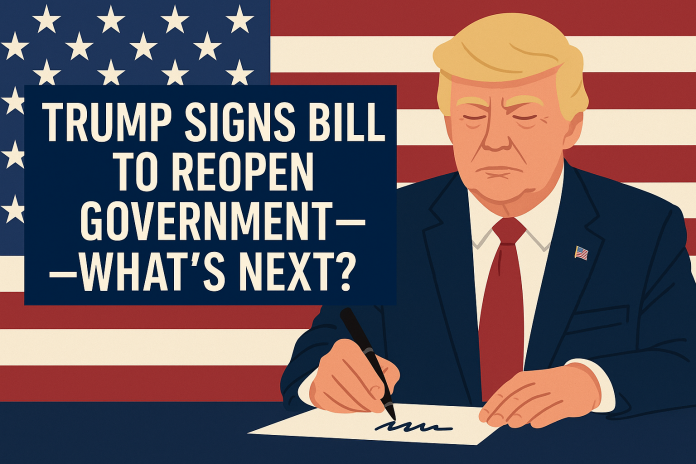️ The Shutdown Is Officially Over — But the Story Isn’t
President Donald Trump has signed the bill to reopen the U.S. government, ending weeks of disruption across federal agencies, national parks, and public services.
While operations are restarting, the reopening raises an important question:
What happens now, and what should Americans expect next?
This guide explains the immediate changes, economic impact, and what to watch as the government transitions back to normal.
✅ 1. What Reopening Means Right Now
When a reopening bill is signed, the federal government begins restoring full operations. This does not happen instantly agencies follow a structured restart plan.
✔ Federal Employees Return
-
Furloughed workers are called back.
-
Back pay is processed as required by federal law.
-
Contractors may resume projects depending on agency approval.
✔ Public Services Resume
Expect gradual restoration of:
-
Passport and visa processing
-
National parks and museums
-
Small Business Administration services
-
IRS operations
-
Federal loan programs
Some services restart within hours, others take days or weeks to reach full speed.
✔ Delays and Backlogs Continue
During a shutdown, applications, permits, research, and inspections pile up.
Even with reopening, processing times will temporarily remain slow.
2. What It Means for the U.S. Economy
Ending the shutdown stops further economic pressure — but the damage doesn’t vanish overnight.
✔ Consumer Confidence Improves
Shutdowns reduce spending. Reopening stabilizes:
-
Retail sales
-
Travel demand
-
Small-business activity
✔ Federal Payments Restart
This affects millions of Americans, including:
-
Federal employees
-
Contractors
-
Businesses awaiting invoices
-
Families using federal benefits
✔ But Lost GDP Isn’t Fully Recovered
Historically, long shutdowns cause:
-
Slower job growth
-
Delayed government contracts
-
Reduced federal output
Economists agree: some losses never return, even after reopening.
⚠️ 3. What Happens Politically After Reopening?
Every reopening has political consequences and these continue long after the shutdown ends.
✔ Short-Term Deal, Not Permanent
Most reopening bills fund the government temporarily.
Another deadline is usually weeks or months away.
This means:
-
Congress must negotiate again
-
Policy disputes may resurface
-
Another shutdown could happen if talks fail
✔ Both Parties Claim Wins
Public messaging shifts instantly:
-
One side argues the reopening was victory for workers.
-
The other says it was necessary for national stability.
But what matters more than politics is what Congress actually does next.
✔ Key Issues Remain Unresolved
Depending on the shutdown’s cause, issues may still be on the table:
-
Healthcare subsidies
-
Border and immigration policies
-
Agency funding priorities
-
Spending caps and fiscal reforms
Reopening simply pauses the fight it doesn’t end it.
4. What Everyday Americans Should Expect Next
Here’s what you should prepare for in the days and weeks after reopening:
✔ Gradual Return to Normal
-
Federal websites return to full updates
-
Federal offices reopen to the public
-
Travel-related backlogs clear over time
✔ Delayed Federal Services
Some functions may still move slowly, such as:
-
IRS refunds
-
Passport renewals
-
Social Security or disability claims
-
SBA loan approvals
✔ Pay Restoration but Staggered
Workers may see:
-
Immediate back pay
-
Staggered disbursement depending on agency systems
-
Updated pay check schedules
✔ New Budget Talks Ahead
Congress will begin preparing for the next funding cycle, meaning:
-
More debates
-
New proposals
-
Possible standoffs
This makes the reopening the start of the next political phase, not the end of the previous one.
5. How Reopening’s Usually Change Public Opinion
Shutdowns affect millions of households. After reopening:
-
Public scrutiny intensifies
-
Citizens assess which leaders “stood firm” or “caused damage”
-
Election narratives begin to shift
Reopening’s often become a major campaign talking point, especially in election years.
Final Takeaway — Reopening Is a Relief, Not a Resolution
The signing of the bill brings:
-
Stability
-
Paychecks
-
Restored services
-
Improved economic sentiment
But the bigger challenge now is what comes after reopening:
-
Budget negotiations
-
Political disputes
-
Long-term funding solutions
-
Preventing future shutdowns
For Americans watching closely, the key question isn’t just “Is the government reopened?”
It’s:
“Will it stay open — and what changes are coming next?”



